|
This article has been published in Topical Time, the bimonthly magazine of the ATA, the American Topical Association.
Through mediation of our USA member Tom Noonan we have permission from the author, George DeKornfeld, to publish it in the MFN newsletter. This time the second part. Click here for part 1.
Half the Wheels, Double the Fun (2)
An additional use for motorcycles, of course, was to aid in the delivery of mail, a fact not lost on the folks at Royal Mail, as can be seen in the next pictorial found struck on a Regional Postcard (SEPR = South East Postal Region) on its First Day of Issue (Figure 6). Pictured is a trike, or three-wheeler, that Royal Mail named a "Post Car" that was used experimentally during 1910 in Sittingbourne, Kent. Our postmark was applied at the southern seaside resort of Brighton in 1982.
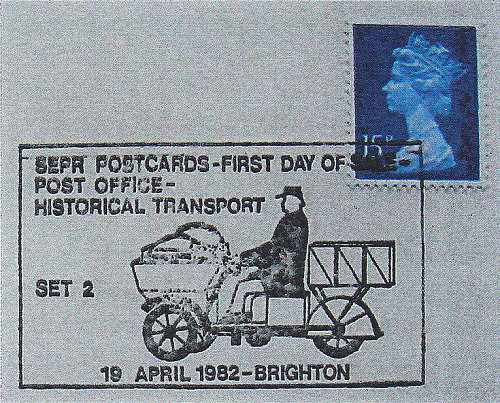
Figure 6
While we're in Old Blighty, feast your eyes on the spectacular pictorial found in Figure 7! Shown with perfect concordance between the 68-pence stamp and its marking is the 1914 Royal Enfield Small-Engined Motor Bicycle. The British Royal Enfield Co. (not to be confused with Royal Enfield – India, a successor that is still producing bikes) started out as a sewing needle factory in 1851. Owned by one George Townsend, the factory was located in the town of Reditch, Worcestershire, where our pictorial was appropriately issued in 2005.
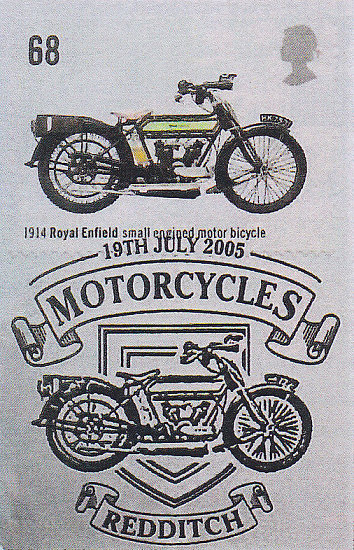
Figure 7
George's son, George Jr. expanded the business into bicycles, and eventually motorcycles with the first one having been assembled in 1901. Another motorcycle company with a tumultuous history, Royal Enfield was sold to the Birmingham Small Arms (BSA) Company in 1907, although the Enfield name was used right up until 1957 when what was left of the company was sold to Enfield of India. Royal Enfield is perhaps best remembered for its "Bullet", the longest-lived motorcycle design in history.
Next, we cross the Channel to visit the Continent, starting with an oldie from Stuttgart, Germany that celebrated the 1937 International Solitude Rennen (Race). Starting off in 1903 as a course for both cars and 2-wheelers, the race was motorcycles only from 1927 to 1937, the track then reduced down to 11 km from its original 22. Always held at the Stuttgart Game Preserve using Solitude Castle, a hunting lodge built in 1764 by Duke Karl Eugen of Württemberg, as its finishing line, its last competition was held there in 1965 (Figure 8).
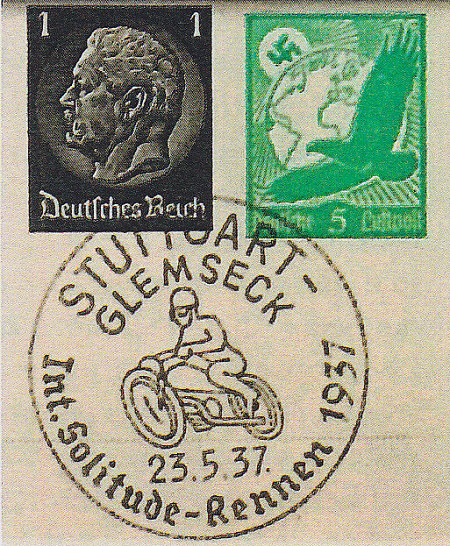
Figure 8
A quick hop eastward and we find ourselves in the country of my father, Hungary. Although born into the Royal Family in 1918, my father wasn't immune to the law that required its adult male citizens to serve in the country's armed forces. The way the story goes, while at one of the weekend training encampments, a buddy of my father's talked him into trying out his army-issue motorcycle. After a brief tutorial on the controls, and in spite of my dad's premonition that this wasn't going to end well, away he went, riding a small circle in front of the tents.
Just as he thought he was getting the hang of it, one of the generals appeared for a surprise inspection. Being a good soldier, as he motored past the general, my father followed proper procedure and saluted his superior officer. However, to my father's horror, the throttle of the bike had somehow become stuck, and in a scene reminiscent of Hogan's Heroes with Col. Klink at the handlebars, Dad, who in his panic had forgotten about the brakes and the clutch, circled the general five more times, saluting each time, much to the amusement of his compatriots. With the general now howling with laughter, Dad's buddy, finally realizing what had happened, pulled him from the bike. Even though he rode for a while in his 20s, I think we may have stumbled upon the genesis of my father's disdain for motorcycles!
Anyway, in Figure 9 we find a splendid Hungarian Maximum Card, used at Budapest in 1985, that celebrates the centenary of the Daimler Kerosene-burning "Riding Car".
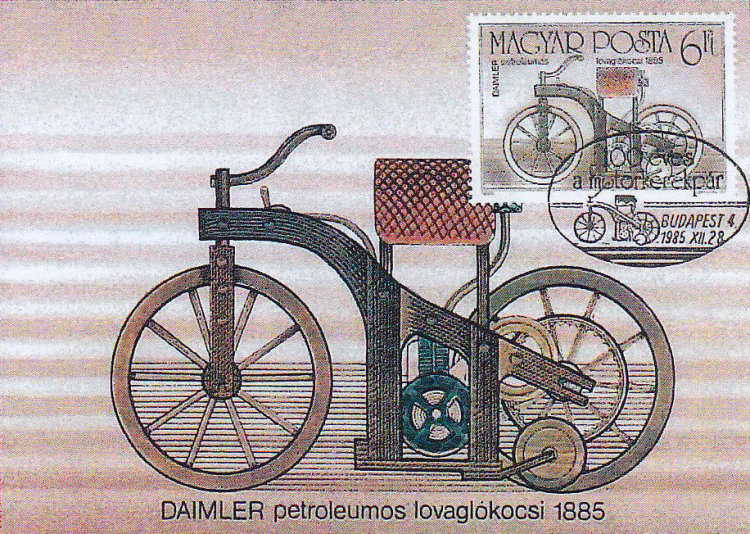
Figure 9
Built by Gottlieb Daimler and Wilhelm Maybach in 1885, the Einspur (Single Track) was the first internal combustion engine motorcycle built, and as such, Daimler is considered to be the father of the motorcycle. A replica of the Einspur, exhibited at the Mercedes Benz Museum in Stuttgart, can be seen in Figure 10 (picture Wladyslaw, https://commons.wikimedia.org/wiki/File:Daimler_Reitwagen.JPG).
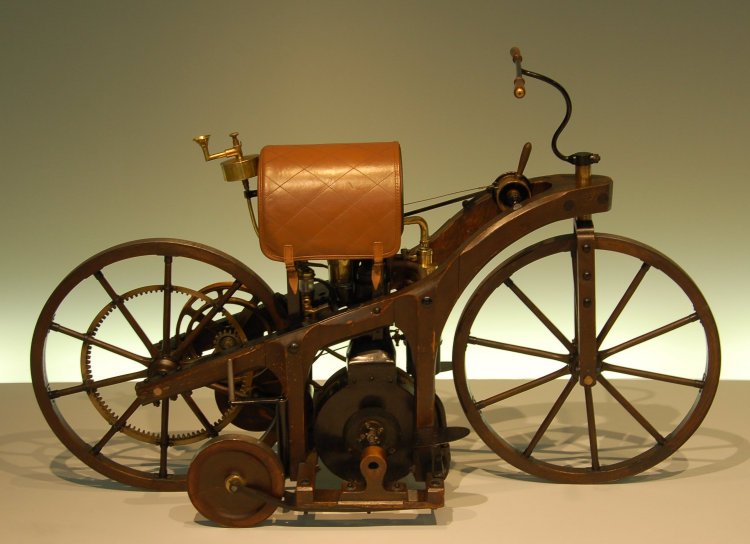
Figure 10
Next, we'll cruise over to Poland to check out a postal card issued in 2019 that commemorated the hundredth birthday of Huta Ludwików Ironworks, located in the south-central city of Kielce. Makers of automotive parts for the European market as well military equipment, important to our story is the company's having produced motorcycles between 1938 and 1970 under the name "SHL", the initialism for Suchedniowska Huta Ludwików (Ludwików Ironworks of Suchedniów, Huta Ludwików's progenitor). The firm's first model, the SHL-98, produced in 1938 (and interestingly powered by a British-made Villiers engine), is pictured both in the stamp and the pictorial (Figure 11).
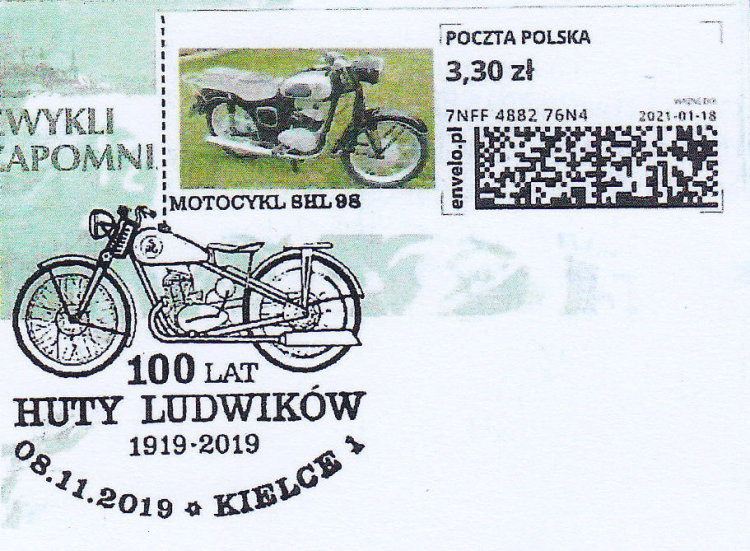
Figure 11
Sweden got in on the racing theme in our next marking, used in 1966, the year it hosted the International Six Day Enduro (ISDE) competition. Held at Villingsberg, this was the 41st time this time-trial race was run and Sweden's second time as host, their first time being in Stockholm in 1923. The ISDE is the world's oldest off-road trial, the first event having been held at Carlisle, England in 1913. "Enduro" refers both to the style of the off-road race, and to the type of motorcycles ridden in them, basically dirt bikes with modifications such as larger gas tanks and much heavier suspensions. Sweden's team of four riders took the trophy at Stockholm, but the East German team won it 1966, the year of our pictorial (Figure 12).
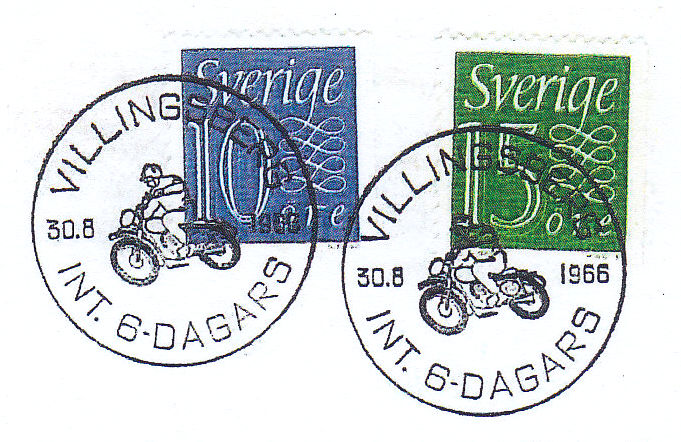
Figure 12
Iceland came up with a nifty pictorial using just a motorcycle tire mounted on a classic spoked wheel, confirming that there is beauty in simplicity. You can almost see the sun reflecting off of the highly polished chrome spokes on this cleverly designed First Day marking that was used at the capital, Reykjavík, in 2005 (Figure 13).
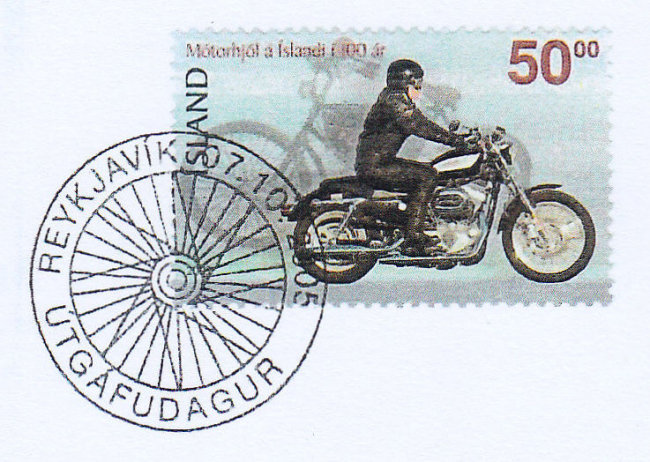
Figure 13
As we bike along, we would be remiss if we did not include one of the typical red markings brought to us by our friends at Nippon Post. July 1, 2004 marked the 50th Anniversary of the formation of the current Japanese Police Force, an event celebrated in part by the cancellation found in Figure 14. The fine detail in this first-day marking, depicting a motorcycle cop on his machine, is a pleasure to look at and way more enjoyable than seeing the real thing in your rear-view mirror, especially if the lights are flashing.
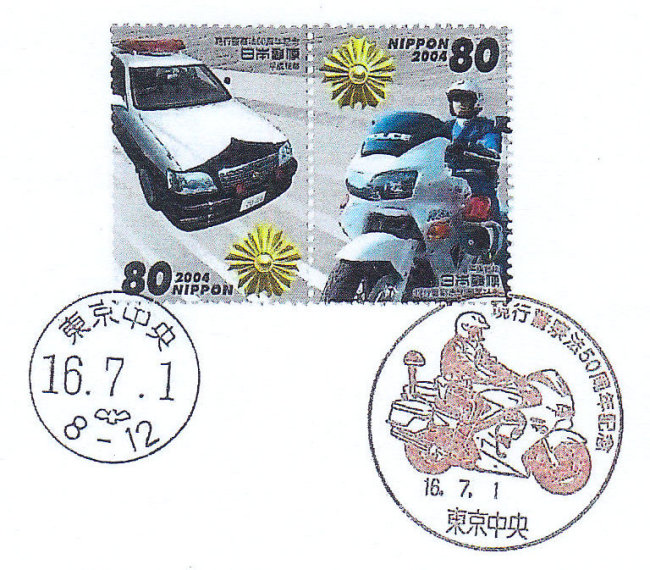
Figure 14
Well, we've reached the final leg of our journey, so we're back in the good old U.S. of A. Here we'll start off with an absolutely spectacular illustrated advertising cover used in 1928 by the Indian "Motocycle" Company (OK, OK, I know, there's no motorcycle pictorial involved here… but there is a pictorial… of an Air Mail plane in the machine cancel… that I'm using as a lame excuse to sneak this cover in, only because my eyes pop out every time I see it!).
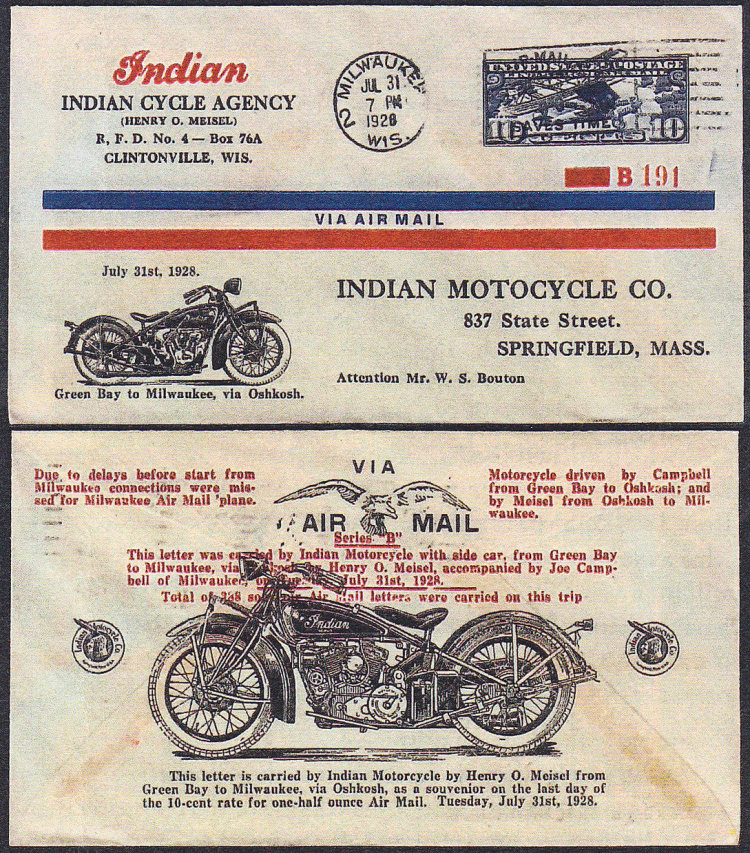
Figure 15
Indian Motocycles are an American classic, right up there with Harleys, and have been made since 1901, being built at what started off as a bicycle factory, the Hendee Manufacturing Company, which opened in 1897. The originals were manufactured from 1901-53 in Springfield, Massachusetts, and fortunately are still in production, the company having changed hands several times over the years. Polaris is the current owner.
Currently there are sixteen or so models in production, with names like the Chieftain, the Scout, and the Challenger Dark Horse, all names befitting the name of the company that builds them. Here our philatelic connection is that an Indian was used to transport 388 souvenir Air Mail letters, this cover included (shown front and back in Figure 15) from Green Bay to Milwaukee, via Oshkosh on the last day of the 10¢ airmail rate (for a ½-ounce) on July 31, 1928. As printing on the cover explains, due to delays before the outset, the Indian with its side car missed the airplane connection at Milwaukee!
Speaking of Indians, the stamp used to present our next marking depicts a handsome example of their 1940 vintage Indian Four. The stamp is tied by a 2006 USPS digital color postmark on its first day, issued at Sturgis, South Dakota (Figure 16).
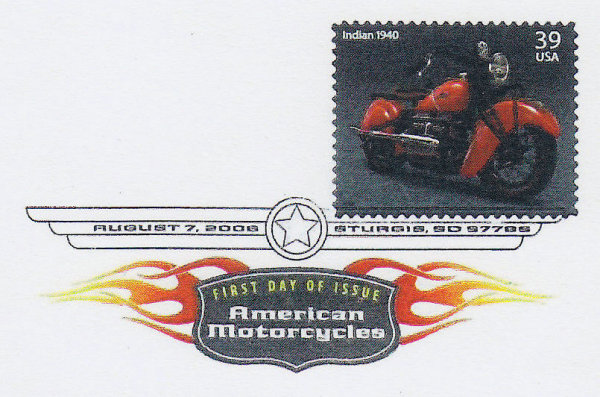
Figure 16
Another stamp in the same set, also mailed at Sturgis, depicting a 1965 Harley Davidson Electra-Glide, can be found in Figure 17. The nicely designed pictorial here is the official USPS rubber stamp First Day marking.
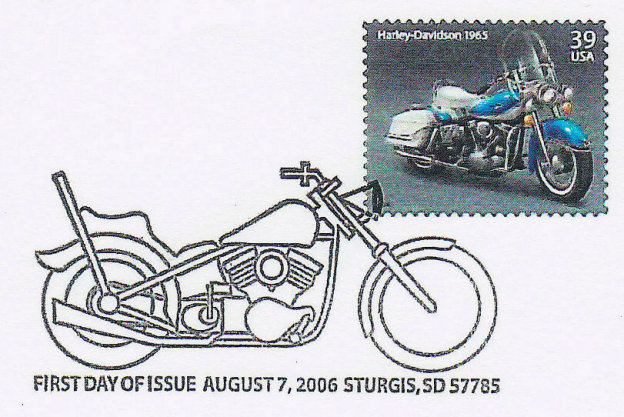
Figure 17
The connection Sturgis has with biking is fairly widely known, and the mere mention of the name to an avid biker has been known to create various physiological responses, a transient tachycardia being at the top of the list. Held each August since 1938 (except for a few years during World War II due to gasoline rationing), the Sturgis Motorcycle Rally was conceived by an Indian motorcycle club known as the Jackpine Gypsies. The first meet, held for the purpose of holding a single race, was called the Black Hills Classic. Today, multiple races are held with different classes of bikes, there's stunt driving, buying, selling, show-and-telling, and a huge group of fellow believers getting together for ten days of everything motorcycle. Attendance averages out to about 500,000 per year (2015 holds the title at 700K!) so the effect on the local economy is enormous. A 2004 pictorial, "Harley Station", can be seen as Figure 18 while Figure 19 pictures a typical scene from the rally.
(picture Cumulus Clouds, commons.wikimedia.org/w/index.php?curid=2346862)
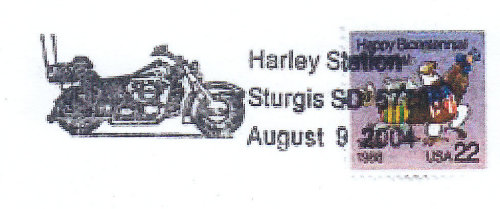
Figure 18
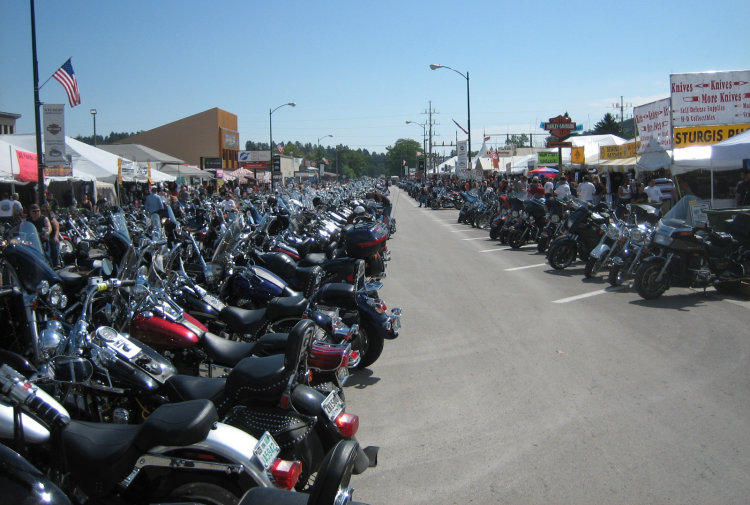
Figure 19
Our final American pictorial features the venerable Honda Gold Wing, arguably the most comfortable touring bike ever produced. Rolled out in 1974 as a 1000 cc machine, by 2001 the Gold Wing had grown in engine size to a massive 6-cylinder, water-cooled 1832 cc behemoth, providing the rider with the feeling of sitting on top of a Volkswagen. Add a fairing, a sissy bar and a stereo, and you were good to go - even cross-country - in pretty much total comfort (torrential downpours excluded). This cancellation, designed to remind drivers to watch out for - and share the roads with - bikers, was used at Statesville, North Carolina, in 2009 (Figure 20).
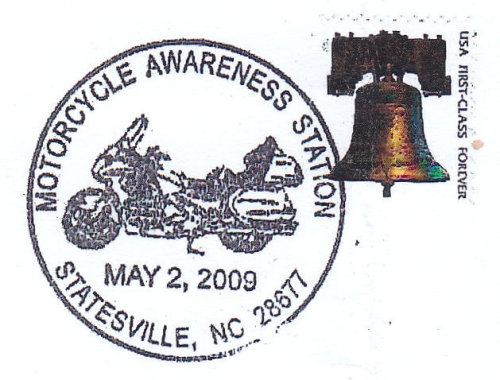
Figure 20
Now, one more for the road, as it were. Rumor has it that after repeatedly getting his cassock caught up in the chain, the Pope has decided to give up riding, leaving his motorcycle parked permanently in front of the Vatican (Figure 21). Yeah, I know that's a stretch, but for the life of me I couldn't figure out why the Vatican would be using a motorcycle in a pictorial so I went for the cheap laugh, no doubt costing me an extra 10-minutes in the confessional.
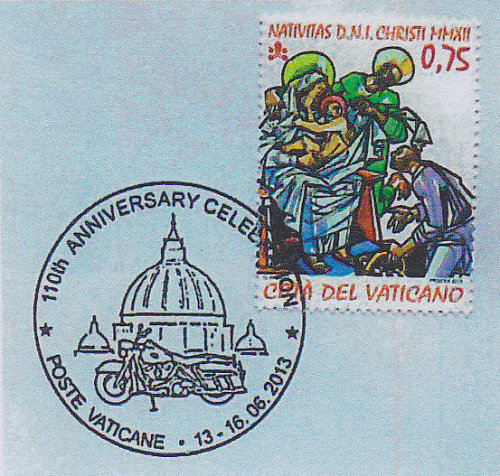
Figure 21
Note by MFN editor: The pictorial of the Vatican has been made on the occasion of a meeting in Rome in 2013, for the celebration of the 100st anniversary of Harley-Davidson. See the article in MFN newsletter 106 (December 2013) and figure 22.
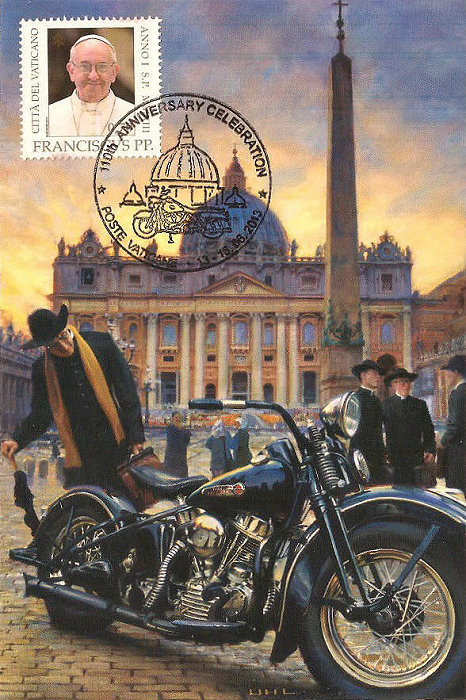
Figure 22
Now, where did I put that brochure on Trikes? Enjoy your Summer, keep safe, and until next time… but of course, the ending joke:
While riding my Harley, I swerved to avoid hitting a deer, lost control and landed in a ditch, severely whacking my head.
Dazed and confused, I crawled out of the ditch to the edge of the road, when a shiny new convertible pulled up with an exceptionally beautiful woman who asked, "Are you okay?"
As I looked up, I noticed she was wearing a low-cut blouse with cleavage to die for.
"I'm okay I think" I replied as I pulled myself up to the side of the car to get a closer look.
She said "Get in and I'll take you to my place, so I can clean and bandage that nasty scrape on your head".
"That's nice of you" I answered, "but I don't think my wife would like me doing that!"
"Oh, come now, I'm a nurse" she insisted. "I need to see if you have any more scrapes and then treat them properly."
Well, she was really pretty and very persuasive. Being sort of shaken and weak, I agreed, but repeated, "I'm sure my wife won't like this."
We arrived at her place which was just a few miles away and, after a couple of cold beers and the bandaging, I thanked her and said, "I feel a lot better, but I know my wife is going to be really upset so I'd better be going."
"Don't be silly!" she said with a smile. "Stay for a while. She won't know anything. By the way, where is she?"
"Still in the ditch, I guess."
George DeKornfeld
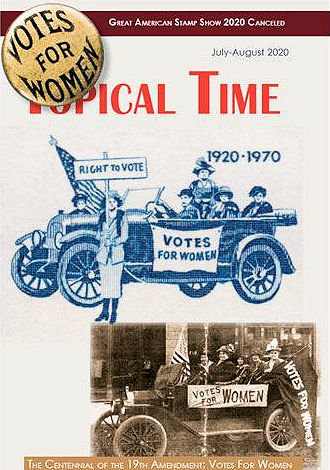
The original article has been published in Topical Time Julu-August 2020
Top - Back to former page - Home |

















